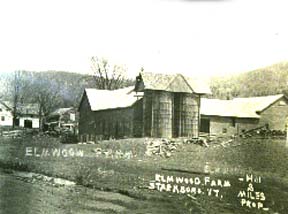TAKING
CARE OF YOUR OLD BARN
A Short History of Vermont Agricultural Buildings
 Vermont
farm families have continually adapted their barns and farm buildings to
keep up with changing markets, technology, and styles. For early families,
a single barn provided shelter for livestock, a storage space for grain
and animal fodder, and a protected area for work and chores.
Vermont
farm families have continually adapted their barns and farm buildings to
keep up with changing markets, technology, and styles. For early families,
a single barn provided shelter for livestock, a storage space for grain
and animal fodder, and a protected area for work and chores.
By the 1850s Vermont farmers faced
increased competition from farm products shipped by railroad from western
states, and they began specializing in dairying and other income-producing
activities. On many farms the main barn became the dairy barn, as farmers
built separate for horse stables, granaries, corn cribs, poultry houses,
shops and equipment sheds. In the second half of the nineteenth century
new machines for mowing and harvesting allowed families to farm more land
and increase their livestock. Farmers built very large barns to house their
herds and to reincorporate many of the functions that had for a time been
in separate buildings. As the making of silage became popular, interior
and then exterior silos became a fixture on dairy farms. To improve sanitation,
farmers began keeping milk cool in small milk houses attached or next to
their dairy barns.
In the twentieth century dairying
became the dominant farm activity. Tractors and electrical power transformed
much farm labor. Sanitation regulations required washable concrete floors
in barns and the cooling of milk in separate milkhouses and then bulk tanks.
Buildings for horses gave way to equipment sheds for motorized field equipment.
Purchased bulk feed replaced many traditional grains raised since first
settlement. Although the number of farms in Vermont has dropped dramatically,
the amount of milk produced has not.
© 1995 Vermont Division for Historic Preservation
and Vermont Housing and Conservation Board. All rights reserved.
Forward to Historic Barn Types...
Back to the Table of Contents...
 Vermont
farm families have continually adapted their barns and farm buildings to
keep up with changing markets, technology, and styles. For early families,
a single barn provided shelter for livestock, a storage space for grain
and animal fodder, and a protected area for work and chores.
Vermont
farm families have continually adapted their barns and farm buildings to
keep up with changing markets, technology, and styles. For early families,
a single barn provided shelter for livestock, a storage space for grain
and animal fodder, and a protected area for work and chores.